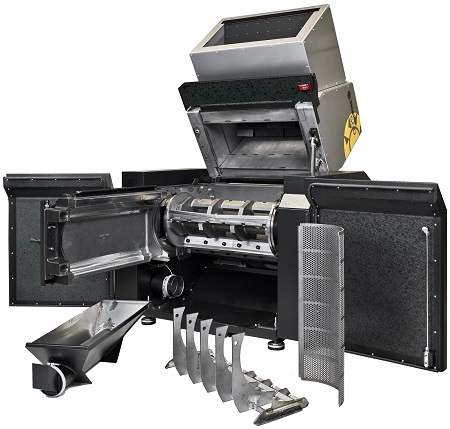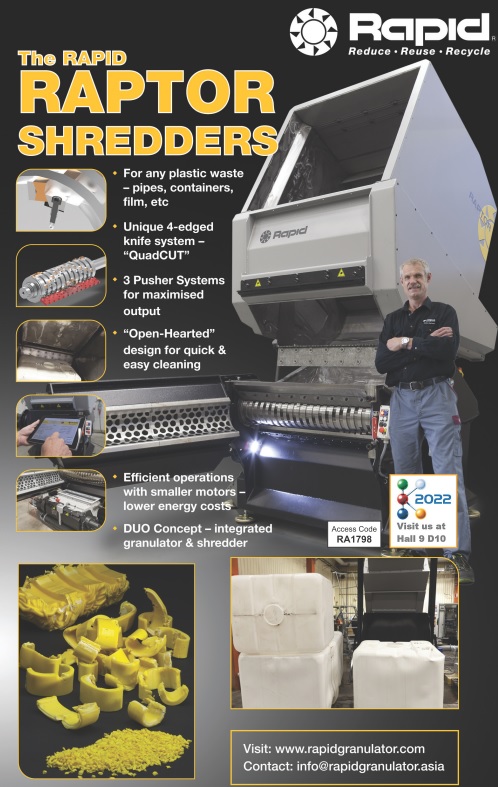By Ravi Purushotham, Director–Asia Pacific, Rapid Granulator AB, Sweden.
Every plastics processing facility generates both startup waste, and a certain level of imperfect product that is rejected as scrap. For many processors, successfully reclaiming their scrap can make the difference between profit and loss. Whether it is recycled back into the process or sold to others for recycling, scrap usually must be reduced to a manageable and uniform size. That is where granulation and shredding equipment come in.
Buying a shredder when you really needed a granulator, or vice-versa, could cost you thousands of dollars in the purchase of a machine that just will not work for your application, or will not provide the production rates that your processing requires. An understanding of your application can save you thousands on equipment costs by helping you select the right machine.
Granulator (also called Crusher) and Shredder are interchangeably used in the industry to describe machines for size reduction of plastic waste. Understanding them is the first step in making the right choice between these two machines.
Granulators are a common sight in plastics processing plants, and can be:
Beside-the-machine models: usually used to grind relatively small volumes of rejects (sprues, trims, etc) for immediate recycling back into the process.
Central granulators: are often located away from the processing machine in a separate room. They are usually bigger, more powerful and are used to chop large volumes of scrap. Generally, granulators operate at high speeds of 400-700 rpm and with relatively low torque.
Shredders, on the other hand, tend to operate at lower speeds (100 to 130 rpm) with high torque that allows them to size-reduce any plastic waste. These machines can be single-shaft designs that cut down against one or more stationary bed knives, or dual-shaft models with two counter-rotating shafts that cut against each other. Dual-shaft models are more efficient in shredding bulky scrap. However, they are complex, prone to shaft damage and in addition, knife maintenance is doubled. Single-shaft models typically provide a larger, more robust rotor and utilise stationary bed knives, thus simplifying service and offering heavier duty operation. As such, single shaft models are rapidly gaining popularity in the plastics industry.
Almost all plastic waste from a plastic processing plant could be processed equally well by either a granulator or a shredder. So, how do you determine which is a better choice? The full answer to this question is a bit more involved, but it basically depends on three factors:
1. What is the material you need to reduce in size?
2. How much waste will be processed?
3. How small do you want the final product to be?
A good understanding of the above will help determine whether your money is best invested in a shredder, a granulator, or perhaps even a combination of the two machines.

What is the material you need to reduce in size?
Some scraps, such as purgings that are several mms thick and heavy, can put a considerable strain on size-reduction equipment. Tossing one into a granulator can create a lot of strain on the machine and potentially damage the granulator.
Shredders, on the other hand, can handle purgings with no problem. A whole bin full of them can be dumped in the open hopper and the machine will shred them quite efficiently.
Rolls of plastic film or fibre, some weighing hundreds of kgs each, are other examples of scrap that are ideal for shredding. The entire roll can be dropped into a shredder while, to process the same scrap through a granulator, the roll stock would need to be cut into slabs or unwound before it could be granulated.
Bulky products such as bottles or containers can bounce around in a shredder that ignificantly reduces cutting efficiency and hence output. These lightweight bottles or containers would pose no problem for a granulator.
How much waste needs to be processed?
There really is no minimum throughput rate for a granulator. Small, beside-the-machine granulators are designed for handling a steady stream of scrap at rates from 5kg/hr to about 300kg/hr. Larger, central units can be installed to handle up to a maximum of 4 tonnes/hr. The only real limitations are the size and configuration of the feed opening and cutting chamber, and the need to avoid over-feeding and thereby jamming the rotor.
Shredders, on the other hand, do not normally work efficiently (and sometimes will not work at all) at extremely low throughputs. The more scrap there is in the cutting chamber and the heavier it is, the easier it is for the ram to push it forward into the rotor. The forward pressure of the feed ram and the rotor drive are continually monitored and controlled so that the feed rate is optimised for aggressive shredding without overloading and maximising output.
How small do you want the final product to be?
Probably the biggest difference between a granulator and a shredder is the form and size of the scrap after size reduction. A shredder chops scrap into “shreds” that are as large as 50mm diameter to less than half that size.
A granulator on the other hand produces “regrind” of particle size of 6-10mm generally that are closer to the size of virgin pellets. A well-designed and maintained granulator is the best tool available to produce consistently uniform granulate that can be added back to the moulding machine or extruder without further processing.
Shreds from the shredder will not be a problem if the material is going to be shipped off to a recycler for resale and or reprocessing. However, if the material is going to be returned to the moulding machine or extruder in a blend with virgin pellets, shredded scrap must go through a secondary granulation process to develop optimal size and uniformity.
Final Comments
Just because granulators and shredders operate differently, and each has different advantages, does not mean processors must choose one or the other. In fact, shredders often perform the coarse size-reduction task, while the scrap is subsequently channelled into a granulator for final sizing to yield a consistent, uniform feed material.


 iConnectHub
iConnectHub
 Login/Register
Login/Register Supplier Login
Supplier Login



























